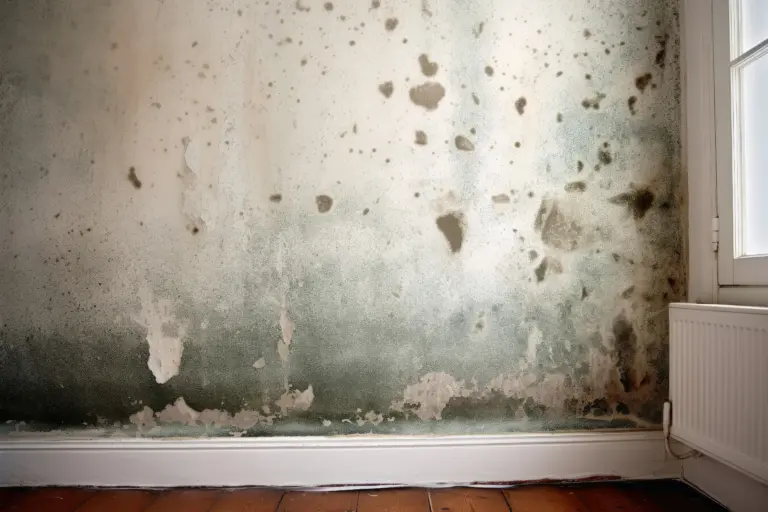Introduction
The dream of owning a home in the UK often includes visions of cosy corners, crackling fireplaces, and Sunday roasts. But what happens when dampness casts a shadow on this idyllic picture?
The question How much does damp devalue a house? It becomes a chilling whisper, echoing through the minds of prospective buyers and frustrated homeowners alike. Fear not, read on to dive into the murky depths of dampness, unearthing its financial impact and unveiling strategies to navigate this watery challenge.
From Surface Stains to Structural Damage
Before unravelling the financial woes, let’s understand the different types of damp and their potential damage:
- Condensation: Often caused by poor ventilation, this surface dampness creates unsightly stains and can lead to mould growth.
- Rising Damp: Moisture travels upwards from the ground, weakening walls, floors, and plasterwork.
- Penetrating Damp: Leaks, cracks, and faulty gutters allow water to intrude, causing widespread damage and potential structural issues.
How Damp Sucks Away House Prices
The impact of dampness on a house’s value can be significant, depending on the type, severity, and location of the problem. Here’s a spectrum of potential devaluation:
- Minor Condensation: While unpleasant, minimal dampness might result in a 5-10% price reduction, especially if easily treatable.
- Extensive Condensation or Rising Damp: More widespread issues could see values drop by 10-20%, potentially requiring further investment to rectify.
- Severe Damp or Structural Damage: In extreme cases, extensive or neglected dampness can shave off a staggering 30-50% of the property’s value, making it difficult to sell and potentially requiring major renovations.
The Hidden Costs of Damp
The financial drain doesn’t stop at the initial devaluation. Damp can lead to a cascade of downstream costs:
- Repair Expenses: Fixing the root cause of damp, from addressing ventilation issues to investing in specialist treatments, can be significant.
- Health Concerns: Mould and damp can aggravate respiratory problems and allergies, leading to medical expenses and potential legal issues if you rent the property.
- Energy Inefficiency: Damp homes are harder to heat, driving up energy bills and impacting long-term sustainability.
- Mortgage Mayhem: Lenders might be hesitant to offer mortgages on damp-ridden properties, adding another layer of complexity to the selling process.
Insurance: Is Damp Covered by My Policy?
A glimmer of hope shines through in the form of insurance. However, navigating the fine print is crucial:
- Home Insurance: Standard policies often exclude cover for dampness caused by lack of maintenance or neglect.
- Buildings Insurance: Some policies might offer cover for damage caused by sudden or accidental water ingress, such as burst pipes or flooding.
- Specialist Damp Cover: Specific add-ons to your insurance can protect against dampness and related repair costs.
Always remember: Check your specific policy wording and consult with your insurance provider for definitive clarity on your coverage.
Strategies for Conquering the Moisture
Here are some practical steps to tackle the damp head-on:
- Identify the Source: Diagnose the type and root cause of the dampness to tailor your approach. Professional surveys can be invaluable.
- Address the Problem: Take swift action to fix the source of the dampness, whether it’s improving ventilation, repairing leaks, or installing damp-proofing solutions.
- Seek Expert Help: Don’t attempt complex repairs yourself. Consult qualified builders or damp specialists for guidance and effective treatment.
- Prevention is Key: Regular maintenance, proper ventilation, and early detection of moisture issues can go a long way in preventing future damp problems.
Buying a House with Damp: Is it Risky?
For prospective buyers, encountering a damp house presents a dilemma. However, here’s how to navigate the situation:
- Negotiate with Clarity: If dampness is present, don’t shy away. Use it as leverage to negotiate a lower price reflecting the cost of repairs.
- Conditional Offer: Make your offer conditional on a satisfactory damp survey and repairs being completed before completion.
- Seek Expert Advice: Consult a surveyor and solicitor to understand the extent of the problem and its potential costs before committing.
Conclusion
So, how much does damp devalue a house? The answer, like moisture itself, can be fluid and fluctuate depending on the specific circumstances. But by understanding the types of dampness, their financial impact, and the available solutions, you can navigate the watery challenge with confidence.
Remember: Damp may cast a shadow, but it doesn’t have to dictate your fate. With proactive action, expert guidance, and a healthy dose of knowledge, you can transform your damp dilemma into a dry delight, safeguarding your home’s value and creating a healthy, comfortable haven for years to come.
Beyond the financial concerns, prioritise the health and well-being of yourself and your loved ones. Damp homes can exacerbate respiratory issues and allergies, so addressing the problem swiftly is crucial. Embrace the resources available, from qualified professionals to specialist insurance options, to ensure effective treatment and peace of mind.
Ready to embark on your home buying or selling journey? Whether it’s finding your dream home or making a successful sale, Michael Anthony Estate Agents is here for you every step of the way. Contact us today and let’s turn your property dreams into a reality!
For personalised guidance on selling your property in the UK, consider consulting with Michael Anthony Estate Agents who can provide expert advice tailored to your specific circumstances.
